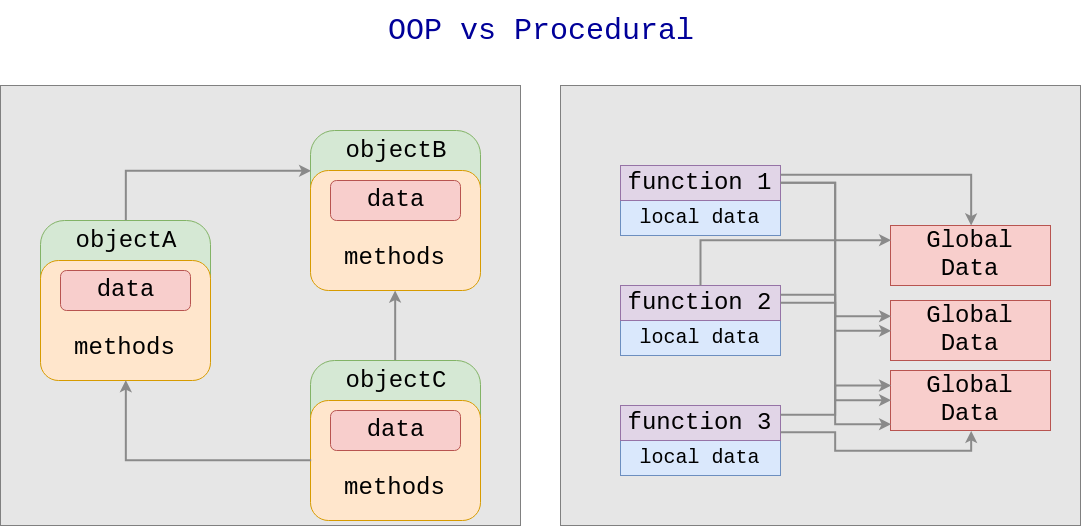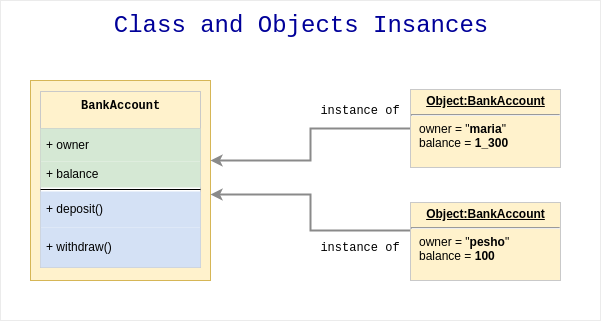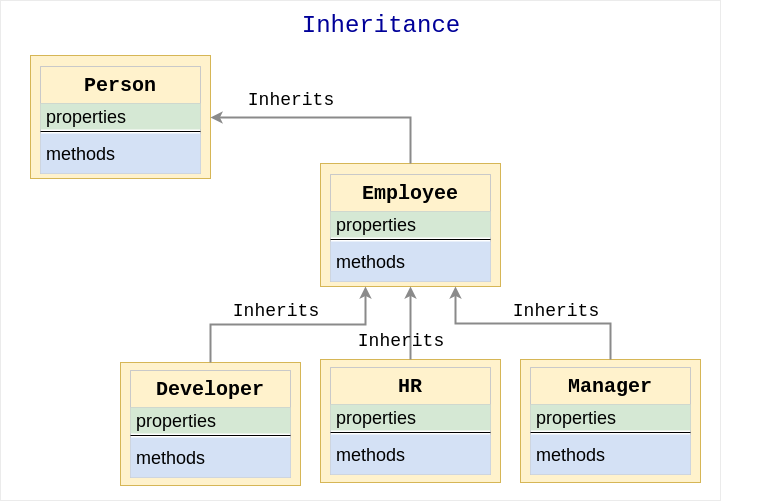OOP in Python
Created for
Object-oriented Programming Paradigm
Object-oriented Programming Paradigm
A step over Procedural Programming
- In procedural-languages (C, Fortran, Pascal) the data structures are separated from algorithms of the software entities (a step over Assembly languages)
- But in big projects (consider CRM) it is:
- difficult to describe the problem solely in terms of procedures.
- more difficult to trace which function manipulates which data.
The benefits
- A higher level of abstraction for solving real-life problems.
- The software system can think in therms of objects, communicating with each other.
- Objects are reusable software components, as each encapsulates the data and logic for its operation. A black-box which do what it has to do.
OOP vs Procedural Paradigms

OOP - Main Concepts
OOP - Main Concepts
Class
- A class is a blueprint, template, or prototype that defines and describes objects attributes (data) and behaviour(methods)
- Can be seen as a user-defined data type
Object
- An instance of a class - an entity of given class, that can be used in a program
- Instances of same class have similar properties and behaviour
Diagram

Inheritance
- A class can inherit attributes and methods from another base class, and at the same time to define its own.

Classes and Objects in Python
Classes and Objects in Python
Minimal Class definition
The minimal class definition in Python looks like:
class ClassName:
pass
class Person:
pass
Object Creation
In python, it's simple:
object_name = ClassName()
# create objects of class Person:
pesho = Person()
maria = Person()
# let's check:
print( type(pesho) )
print( type(maria) )
# <class '__main__.Person'>
# <class '__main__.Person'>
Objects created from the same class have same type, but they are different entities:
class Person:
pass
maria = Person()
pesho = Person()
print( maria == pesho)
#False
Attributes
Attributes
Overview
- The attributes describes an object's characteristics.
- Usually, objects from same class, have same attributes, but with different values.
- In python, we can dynamically create arbitrary new attributes for existing objects
Accessing Object's Attributes - the dot notation
# write in object attribute:
object_name.attribute = "value of any type"
# read from attribute:
var = object_name.attribute
maria = Person()
# write in object attribute:
maria.name = "Maria"
print(maria.name)
# read from attribute:
mn = maria.name
print(mn)
As we'll see later, this is not the proper way to create object's attributes in Python. This is an example of dot notation, used to access object's attributes
Attributes - internal
- Attributes are stored internally in a dictionary structure
- Each object has associated dictionary attribute, named
__dict__, which store an object's (writeable) attributes
class Person:
pass
maria = Person()
# set attribute:
maria.name = "Maria"
maria.age = 100
print(maria.__dict__)
# {'name': 'Maria', 'age': 100}
Class Attributes
- You can define Class Attributes, which will be shared across all class instances (the objects)
class Person:
name = "Anonymous"
age = 100
maria = Person()
pesho = Person()
print(maria.name, maria.age)
print(pesho.name, pesho.age)
# Anonymous 100
# Anonymous 100
Methods
Methods
Overview
A method is a function that "belongs to" an object.
Syntax
class ClassName:
def method_name(self):
pass
- Note, that you must define at least one parameter in the method.
- It will take (automatically) a reference to the object, which called that method.
- You can name the parameter as you wish, but the convention is to name it
self
Syntax - example
class Person:
def greet(self):
print("Hi there! I'm", self.name)
# create some objects of class Person:
maria = Person()
maria.name = "Maria Popova"
pesho = Person()
pesho.name = "Pesho"
# call greet() method on maria. Python will send the maria object reference to the self parameter.
maria.greet()
# call greet() method on pesho
pesho.greet()
# OUTPUT:
# Hi there! I'm Maria Popova
# Hi there! I'm Pesho
more on self:
When a method is invoked from an object, Python automatically passes the object reference to the first parameter in the method definition.
class TestSelf:
def test(self, obj):
print(self == obj)
obj1 = TestSelf()
# lets check if obj1 == self
obj1.test( obj1 )
# True
Class Constructor
the __init__() method
__init__() method
What is a Class Constructor
- Class Constructor is a method, called automatically when each new object is created.
- A class constructor defines the action which will happens when a new object instance is created.
- Usually, this actions include setting an initial value for the object attributes.
Syntax
- In Python, the Class Constructor is implemented by a special method named
__init__()
class ClassName:
def __init__(self):
pass
Example 1
# class definition
class ClassA:
def __init__(self):
print("An object of ClassA is created!")
# objects creation:
obj1 = ClassA()
obj2 = ClassA()
# output:
# An object of ClassA is created!
# An object of ClassA is created!
Person Class Constructor Example
class Person:
def __init__(self, name, age):
self.name = name
self.age = age
def greet(self):
print("Hi there! I'm {}, {} years old!".
format(self.name, self.age))
maria = Person("Maria Popova", 25)
pesho = Person("Pesho", 27)
maria.greet()
pesho.greet()
# Hi there! I'm Maria Popova, 25 years old!
# Hi there! I'm Pesho, 27 years old!
Magic (dunder) methods
Magic (dunder) methods
- Besides the
__init__()methods in Python, there are many other predefined special methods, also called magic methods, which have the same notation form:
__magic__()
The double underscore is often called dunder, thus the methods - dunder methods
__str__ method
- Called by str(object), format() and print() built-in functions to compute the “informal” or nicely printable string representation of an object.
- You can define inside a class the
__str__()method which will be used, when you call the str(), format() or print() functions of a class instance - The return value must be a string!
example
class Person:
def __init__(self, name, age):
self.name = name
self.age = age
def __str__(self):
return "name = {}\nage = {}\n".format(self.name, self.age)
maria = Person("Maria Popova", 25)
print(maria)
# name = Maria Popova
# age = 25
__repr__ method
- Called by the repr() built-in function, which is titypically used for debugging
- The return value must be a string!
- if a class has only the __repr__ method and no __str__ method, __repr__ will be applied in the situations, where __str__would be applied
example
class Person:
def __init__(self, name, age):
self.name = name
self.age = age
def __repr__(self):
return """# This is representation of an object:
obj = Person()
obj.name = {}
obj.age = {}""".format(self.name, self.age)
maria = Person("Maria Popova", 25)
print(maria)
Note, that the __repr__ method will be invoked, when print(maria) is executed!
__str__ vs __repr__
- Use __str__, if the output should be for the end user or in other words, if it should be nicely printed.
- Use __repr__ for the internal representation of an object. The output of __repr__ should be - if feasible - a string which can be parsed by the python interpreter. The result of this parsing is in an equal object.
Other dunder methods
Exercises on Class Constructor and dunder methods
Exercises on Class Constructor and dunder methods
The BankAccount Class
- Create a BankAccount class, and two objects, as given in the template code
class BankAccount():
pass
maria_account = BankAccount("Maria", 1_300)
pesho_account = BankAccount("Pesho", 100)
print(maria_account)
print(maria_account)
# OUTPUT:
#BankAccount:
# owner = Maria
# balance = 1300
#BankAccount:
# owner = Pesho
# balance = 100
Encapsulation and Data Hiding
Encapsulation and Data Hiding
Python's Way - Conventions
| Naming | Type | Meaning |
|---|---|---|
| name | Public | Attributes, that can be freely used inside or outside of a class definition. |
| _name | Protected | Protected attributes should not be used outside of the class definition, unless inside of a subclass definition. |
| __name | Private | This kind of attribute should be inaccessible and invisible. It's neither possible to read nor write to those attributes, except inside of the class definition itself. |
Private Attributes
Python did not provide a truly private attributes!
The dunder attributes are just prefixed with the _ClassName
class Person:
def __init__(self, name, age):
self.name = name
self.__age = age
def __str__(self):
return "name = {}; __age = {}".format(self.name, self.__age)
maria = Person("Maria Popova", 25)
# let's try to change Maria's age:
maria.__age = 100
print("maria.__age is set to ", maria.__age)
print(maria)
# but __age is not hidden! Look:
maria._Person__age = 100
print("maria.__age is set to ", maria.__age)
print(maria)
Inspecting Classes and Objects
Inspecting Classes and Objects
__dict__ - revealing object's dictionary
class Person:
def __init__(self, name, age):
self.name = name
self.__age = age
maria = Person("Maria Popova", 25)
# inspect object attributes dictionary:
print( maria.__dict__ )
# inspect class attributes dictionary:
print( Person.__dict__ )
dir() - revealing all object's attributes
- The built-in function
dir()used with an object name as argument will reveal most of the attributes defined for that object. Check dir() on python3 docs for more information.
class Person:
def __init__(self, name, age):
self.name = name
self.__age = age
maria = Person("Maria Popova", 25)
print("maria has next attributes:")
print( dir(maria) )
# of course, dir() is calling the __dir__() method on the object, but it's better to use the function call, though you can do that:
print( maria.__dir__() )
Resources
YouTube Videos
Python Classes and Objects - John Philip Jones
blogs, tutorials
- Object-Oriented Programming www.python-course.eu
Exercises
Task1: students_objects.py
The Task
- Define a class
Studentwith method__init__(), such that the creation of objects from Student Class looks like:
# objects creation:
ivan = Student("Ivan Ivanov", ["maths", "phisics"])
alex = Student("Alex Petrov", ["arts", "music"])
maria = Student("Maria Popova", ["chemistry", "biology"])
The Task
- Define method
greet()which will print greeting message from each student, as in the next code snippet:
# use objects:
ivan.greet()
alex.greet()
maria.greet()
#OUTPUT:
#Hello, I'm Ivan Ivanov. My favourite subjects are:
# maths
# phisics
#Hello, I'm Alex Petrov. My favourite subjects are:
# arts
# music
#Hello, I'm Maria Popova. My favourite subjects are:
# chemistry
# biology
You can align text one tab left, using the "\t" escape in the string.
Submission
- Please, prefix your filenames/archive with your name initials, before sending.
- For instance: iep_task1.py or iep_tasks.rar
- Send files to progressbg.python.course@gmail.com
These slides are based on
customised version of
framework

